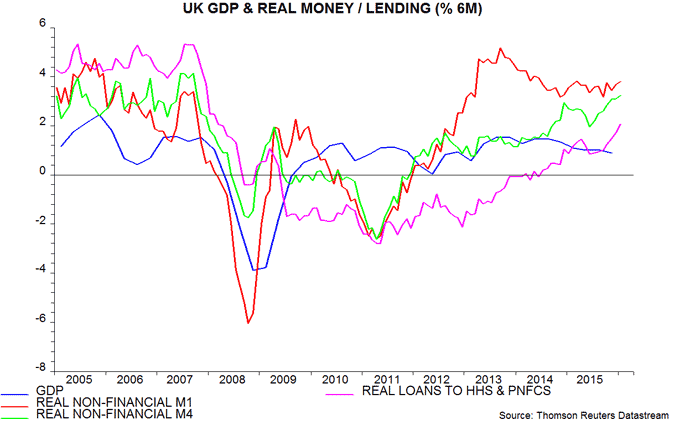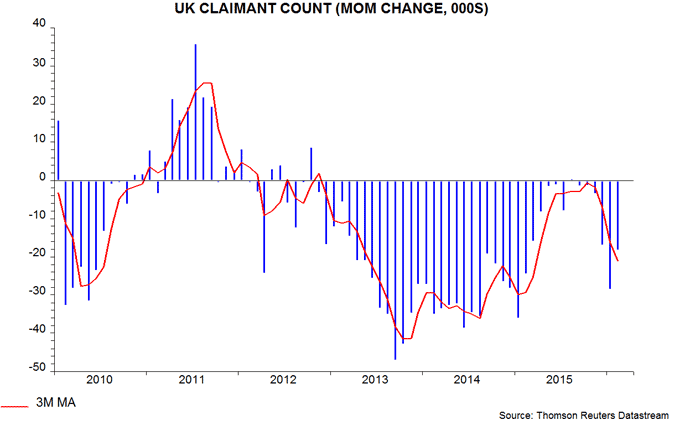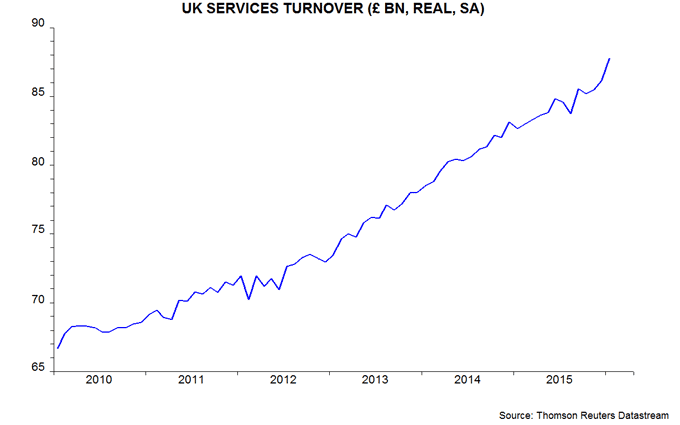Is the UK economy reaccelerating?
UK monetary trends continue to give an upbeat message for economic prospects, contrary to consensus gloom. Incoming news is consistent with this positive assessment.
The average prediction for GDP growth in 2016 has fallen from 2.3% in December to 2.0% in March, according to the Treasury’s monthly survey of forecasters. Increased pessimism may reflect recent weaker purchasing managers’ survey results and confirmation of a summer Brexit referendum, which many expect to cause near-term spending restraint.
The purchasing managers’ surveys are regarded here as of little value for forecasting purposes. They rarely lead the economy, and minor fluctuations within the normal range are poorly correlated with GDP growth. They sometimes give misleading signals, as in late 2012, when weak readings contributed to “triple-dip” hysteria, even as economic growth was starting to pick up strongly.
Monetary trends, by contrast, gave clear warning that the economy would surprise on the upside in 2013. Six-month growth of real (i.e. inflation-adjusted) narrow money, as measured by non-financial M1*, rose steadily during 2012 and continued to surge in the first half of 2013 – see first chart.
Real narrow money growth moderated later in 2013 and in 2014, a decline that was mirrored by some loss of economic momentum from mid-2014. It stabilised, however, at a solid level and has firmed slightly recently.
Broad money and credit trends, meanwhile, are significantly stronger than in 2012-13. Six-month growth of real non-financial M4* reached an eight-year high in January – first chart. Real bank lending to households and private non-financial corporations (PNFCs) has also accelerated – the “credit impulse”, therefore, is positive.
GDP is currently estimated to have risen by 0.9%, or 1.8% annualised, during the second half of 2015 (i.e. between the second and fourth quarters). Stronger money / credit trends since mid-2015 suggest that GDP momentum will pick up during 2016.
Incoming news is consistent with this assessment but is being ignored by the consensus. The Citigroup UK economic surprise index was negative for most of 2015 but turned positive in February and recently reached a 23-month high.
Claimant-count unemployment is usually sensitive to changes in economic momentum and has fallen at a notably faster pace since late 2015. A similar pick-up in the rate of decline occurred in early 2010 and early 2013 when GDP was accelerating – second chart.
Services output rose by 0.7% in the fourth quarter and growth in the first quarter may be similar or stronger. The December level of output was already 0.3% above the fourth-quarter average, while services turnover, which is an important input to the output calculation, increased further in January – third chart. 
A post in December argued that GDP growth in 2016 would exceed the then-consensus forecast of 2.3% – this view is maintained.
*Non-financial M1 = notes / coin and sterling sight deposits held by households and private non-financial corporations. Non-financial M4 additionally includes holdings of sterling time deposits, repos and bank securities of less than five years’ original maturity.

Reader Comments